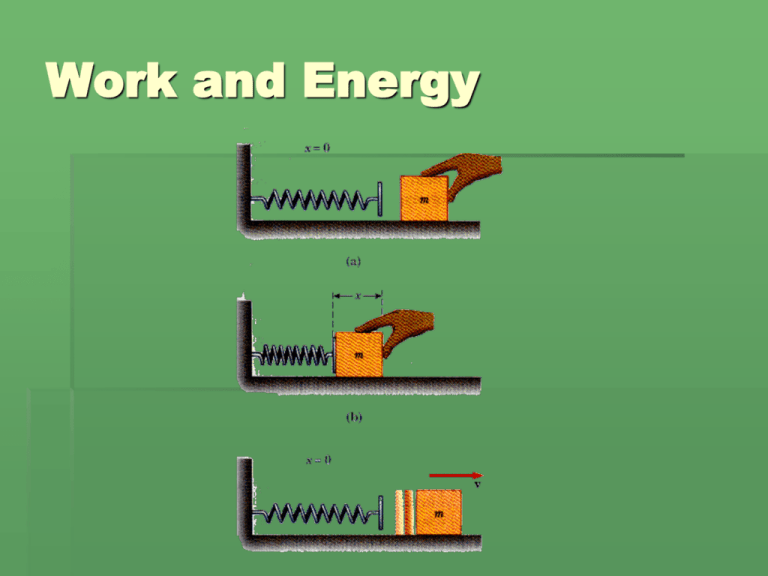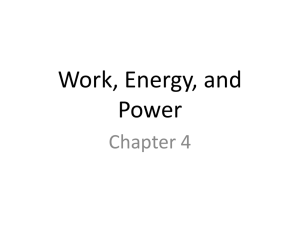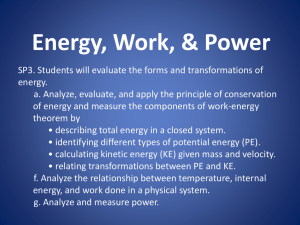Work
advertisement

Work and Energy Vocabulary Work: The use of force to move an object over a distance (Joule or J) Joule: The unit used to measure work; one joule of work is done when a force of one newton moves an object one meter (Joule = Newton ● meter) Power: the rate at which work is done (Watts) Watt: the unit used to measure power; one watt is equal to one joule of work done in one second Horsepower: the unit of measurement for engines and motors; one horsepower equals 745 watts. WORK Force is necessary to do work! Work is done only when an object that is being pushed or pulled actually moves. The work done by a force is related to the size of the force and the distance over which the force is applied. Work= (Force) ● (distance) W= Fd Units: Work (Joules), Force (Newtons), Distance (Meters) Calculating Work (W=Fd) How much work is done if a person lifts a barbell weighing 500 N to a height of 2 meters? I F S M U Calculating Work I: Force= 500 N, distance= 2 m, Work=? F: Work= Force●distance (W=Fd) S: W= 500 N ● 2 m M: 1,000 U: 1,000 J (remember the units for work are joules, units for force are Newtons, and units for distance are meters) Work Objects that are moving can do work Examples: Bowling balls do work on the pins they hit in a bowling alley Baseball bat does work on the ball Gravity does work on falling water Energy is transferred when work is done Energy is the ability to do work or cause change When you do work on an object, some of your energy is transferred to the object. Think of work as a transfer of energy Work and energy are both measured in the same unit, the joule Calculating Gravitational Potential Energy Potential energy (stored energy) that is caused by gravity (downward force) is gravitational potential energy. (GPE) Gravitational potential energy= mass ● gravitational acceleration ● height (GPE = mgh) Calculating Gravitational Potential Energy (GPE=mgh) What is the gravitational potential energy of a girl who has a mass of 40 kg and is standing on the edge of a diving board that is 5 meters above the water? * remember gravitational acceleration is a constant (does not change) so… g= 9.8 m/s2 I F S M U Calculating Gravitational Potential Energy I: mass= 40 kg, g= 9.8 m/s2 , height =5 m, GPE=? F: GPE = mgh S: GPE= 40 kg ● 9.8 m/s2 ● 5 m M: 1960 (kg ● m/s2 ) ● m U: 1960 Joules Remember the unit (Joules = N ● m) Calculating Kinetic Energy KE= mv2 2 Kinetic energy is the energy of motion Kinetic energy= mass ● velocity2 2 Calculating Kinetic Energy KE= mv2 2 What is the kinetic energy of a girl who has a mass of 40 kg and a velocity of 3 m/s I F S M U Calculating Kinetic Energy KE= mv2 2 I: mass= 40 kg, velocity = 3 m/s , KE=? F: KE= mv2 2 S: KE= (40kg ● (3m/s )2 2 ■ M: (40kg ● 9 m2/s2 ) 2 360 2 180 ( kg ● m2/s2 ) (kg ● m/s2 ) ● m N●m 180 N ● m ■U: 180 J (Remember N ● m = J) Calculating Mechanical Energy ( ME= PE + KE) Mechanical energy is the object’s combined potential and kinetic energy Mechanical energy= potential energy + kinetic energy ME = PE + KE Calculating Mechanical Energy ( ME= PE + KE) The potential energy of a girl on a swing just before she is released is 180 J and her kinetic energy after she has been released is 300 J. What is her mechanical energy (total energy) ? I F S M U Calculating Mechanical Energy ( ME= PE + KE) I: PE= 180 J, KE= 300 J, ME=? F: ME= PE + KE S: ME= 180 J + 300 J M: 480 U: 480 J Law of conservation of energy Energy can not be created or destroyed it is just transferred or transformed No matter how much energy is transferred all of the energy is still present somewhere in one form or another Mechanical energy is the combination of both kinetic and potential energy. Power Power is the rate at which work is done Power = Work Time The unit of measurement for power is watt (W) P= W/t Calculating Power from work ( P= W/t) An Antarctic explorer uses 6000 J of work to pull his sled for 60 Seconds. What power does he need? I F S M U Calculating Power from work ( P= W/t) I: F: S: M: U: Work= 6000 J, time= 60 s , P=? P= W/t P= 6000J/ 60 s P=100 J/s ( J/s =Watts) P=100 W Power can be calculated from energy (P=E/t) Power = Energy/time A light bulb used 600 J of energy in 6 s. What is the power of the light bulb? I F S M U Power can be calculated from energy (P=E/t) I: Energy= 600 J, Time= 6 s, P=? F: P=E/t S: P= 600 J/6 s M: P= 100 J/s U: P= 100 Watts







